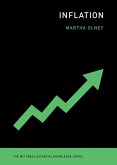- Broschiertes Buch
- Merkliste
- Auf die Merkliste
- Bewerten Bewerten
- Teilen
- Produkt teilen
- Produkterinnerung
- Produkterinnerung
"This is an intermediate to advanced undergraduate macroeconomics text for students to learn by doing rather than reading"--
Andere Kunden interessierten sich auch für
![Financial Economics Financial Economics]() Antonio MeleFinancial Economics272,99 €
Antonio MeleFinancial Economics272,99 €![Modern Macroeconomics Modern Macroeconomics]() Sanjay K. Chugh (Ohio State Unive Associate Professor of EconomicsModern Macroeconomics91,99 €
Sanjay K. Chugh (Ohio State Unive Associate Professor of EconomicsModern Macroeconomics91,99 €![Economic Dynamics, second edition Economic Dynamics, second edition]() John StachurskiEconomic Dynamics, second edition86,99 €
John StachurskiEconomic Dynamics, second edition86,99 €![The Road to Ruin The Road to Ruin]() James RickardsThe Road to Ruin21,99 €
James RickardsThe Road to Ruin21,99 €![Inflation Inflation]() Martha OlneyInflation12,99 €
Martha OlneyInflation12,99 €![Digital Gold Digital Gold]() Nathaniel PopperDigital Gold9,99 €
Nathaniel PopperDigital Gold9,99 €![Big Ideas in Macroeconomics Big Ideas in Macroeconomics]() Kartik B. Athreya (Federal Reserve Bank of Richmond)Big Ideas in Macroeconomics37,99 €
Kartik B. Athreya (Federal Reserve Bank of Richmond)Big Ideas in Macroeconomics37,99 €-
-
-
"This is an intermediate to advanced undergraduate macroeconomics text for students to learn by doing rather than reading"--
Produktdetails
- Produktdetails
- Verlag: MIT Press Ltd
- Seitenzahl: 336
- Erscheinungstermin: 15. Juli 2025
- Englisch
- Abmessung: 225mm x 175mm x 20mm
- Gewicht: 646g
- ISBN-13: 9780262552332
- ISBN-10: 0262552337
- Artikelnr.: 72599879
- Herstellerkennzeichnung
- Libri GmbH
- Europaallee 1
- 36244 Bad Hersfeld
- gpsr@libri.de
- Verlag: MIT Press Ltd
- Seitenzahl: 336
- Erscheinungstermin: 15. Juli 2025
- Englisch
- Abmessung: 225mm x 175mm x 20mm
- Gewicht: 646g
- ISBN-13: 9780262552332
- ISBN-10: 0262552337
- Artikelnr.: 72599879
- Herstellerkennzeichnung
- Libri GmbH
- Europaallee 1
- 36244 Bad Hersfeld
- gpsr@libri.de
Oskar Zorrilla is Assistant Professor of Economics at the United States Naval Academy.
1. The Med
2. Twins
3. Rates and Logs
4. Grade Inflation
5. Standardized Tests
6. The Big Mac Index
7. Exchange Rates and Purchasing Power
8. Bumble
9. The Search for Dates and Jobs
10. Search and Unemployment
11. The Beveridge Curve
12. Choice as Optimization
13. Studying for the Final
14. Beer
15. Dinner
16. Cobb and Douglas are Hiring
17. The Price of Leisure
18. Elasticity
19. When are Market Economies Efficient?
20. The Government Expenditure Multiplier
21. Why Do Americans Work So Much More than Europeans
22. Market Power
23. When Are Market Economies Insufficient?
24. Having Your cake and Eating It, Too
25. Alexander and the National Debt
26. The Value of the Firm
27. The Efficient Market Hypothesis
28. The Current Account
29. Trade Deficits
40. 44 Days
31. The Transversality Condition
32. Misdiagnoses 117
33. The Euler Equation
34. The Capital Markets
35. The Marginal Propensity to Consume
36. The Invisible Hand Across Time
37. Ricardian Equivalence
38. Tax Rebates and Financial Frictions
39. Money, That's What I Want
40. The Printing Press
41. Fisher [and] Price[s]
42. The Price of Money
43. A Simple Model of Inflation
44. A Not-so-Simple Model of Inflation
45. Logs and Expectations
46. The Taylor Principle
47. Fiscal Shocks
48. Currency Pegs
49. The Great Capitol Hill Babysitting Co-op Crisis
50. The Phillips Curve
51. Testing for the Real Effects of Monetary Policy
52. Optimal Monetary Policy
53. Utility and Uncertainty
54. The Risk Premium
55. Uncertainty Shocks
56. The Zero Lower Bound
57. Forward Guidance
58. The Government Expenditure Multiplier Revisited
59. maturity Transformation
60. Diamond and Dybvig Run to the Bank
61. A Contribution to the Theory of Orchards
62. Income per Capita
63. Diminishing Marginal Returns
64. Poverty Traps
Exogenous Technological Progress
66. The Solow Residual
67. Convergence
68. Perfect Competition, Constant Returns and Technology
69. Endogenous Technological Change (or, Romer's Idea)
Mathematical Appendix
Glossary
References
2. Twins
3. Rates and Logs
4. Grade Inflation
5. Standardized Tests
6. The Big Mac Index
7. Exchange Rates and Purchasing Power
8. Bumble
9. The Search for Dates and Jobs
10. Search and Unemployment
11. The Beveridge Curve
12. Choice as Optimization
13. Studying for the Final
14. Beer
15. Dinner
16. Cobb and Douglas are Hiring
17. The Price of Leisure
18. Elasticity
19. When are Market Economies Efficient?
20. The Government Expenditure Multiplier
21. Why Do Americans Work So Much More than Europeans
22. Market Power
23. When Are Market Economies Insufficient?
24. Having Your cake and Eating It, Too
25. Alexander and the National Debt
26. The Value of the Firm
27. The Efficient Market Hypothesis
28. The Current Account
29. Trade Deficits
40. 44 Days
31. The Transversality Condition
32. Misdiagnoses 117
33. The Euler Equation
34. The Capital Markets
35. The Marginal Propensity to Consume
36. The Invisible Hand Across Time
37. Ricardian Equivalence
38. Tax Rebates and Financial Frictions
39. Money, That's What I Want
40. The Printing Press
41. Fisher [and] Price[s]
42. The Price of Money
43. A Simple Model of Inflation
44. A Not-so-Simple Model of Inflation
45. Logs and Expectations
46. The Taylor Principle
47. Fiscal Shocks
48. Currency Pegs
49. The Great Capitol Hill Babysitting Co-op Crisis
50. The Phillips Curve
51. Testing for the Real Effects of Monetary Policy
52. Optimal Monetary Policy
53. Utility and Uncertainty
54. The Risk Premium
55. Uncertainty Shocks
56. The Zero Lower Bound
57. Forward Guidance
58. The Government Expenditure Multiplier Revisited
59. maturity Transformation
60. Diamond and Dybvig Run to the Bank
61. A Contribution to the Theory of Orchards
62. Income per Capita
63. Diminishing Marginal Returns
64. Poverty Traps
Exogenous Technological Progress
66. The Solow Residual
67. Convergence
68. Perfect Competition, Constant Returns and Technology
69. Endogenous Technological Change (or, Romer's Idea)
Mathematical Appendix
Glossary
References
1. The Med
2. Twins
3. Rates and Logs
4. Grade Inflation
5. Standardized Tests
6. The Big Mac Index
7. Exchange Rates and Purchasing Power
8. Bumble
9. The Search for Dates and Jobs
10. Search and Unemployment
11. The Beveridge Curve
12. Choice as Optimization
13. Studying for the Final
14. Beer
15. Dinner
16. Cobb and Douglas are Hiring
17. The Price of Leisure
18. Elasticity
19. When are Market Economies Efficient?
20. The Government Expenditure Multiplier
21. Why Do Americans Work So Much More than Europeans
22. Market Power
23. When Are Market Economies Insufficient?
24. Having Your cake and Eating It, Too
25. Alexander and the National Debt
26. The Value of the Firm
27. The Efficient Market Hypothesis
28. The Current Account
29. Trade Deficits
40. 44 Days
31. The Transversality Condition
32. Misdiagnoses 117
33. The Euler Equation
34. The Capital Markets
35. The Marginal Propensity to Consume
36. The Invisible Hand Across Time
37. Ricardian Equivalence
38. Tax Rebates and Financial Frictions
39. Money, That's What I Want
40. The Printing Press
41. Fisher [and] Price[s]
42. The Price of Money
43. A Simple Model of Inflation
44. A Not-so-Simple Model of Inflation
45. Logs and Expectations
46. The Taylor Principle
47. Fiscal Shocks
48. Currency Pegs
49. The Great Capitol Hill Babysitting Co-op Crisis
50. The Phillips Curve
51. Testing for the Real Effects of Monetary Policy
52. Optimal Monetary Policy
53. Utility and Uncertainty
54. The Risk Premium
55. Uncertainty Shocks
56. The Zero Lower Bound
57. Forward Guidance
58. The Government Expenditure Multiplier Revisited
59. maturity Transformation
60. Diamond and Dybvig Run to the Bank
61. A Contribution to the Theory of Orchards
62. Income per Capita
63. Diminishing Marginal Returns
64. Poverty Traps
Exogenous Technological Progress
66. The Solow Residual
67. Convergence
68. Perfect Competition, Constant Returns and Technology
69. Endogenous Technological Change (or, Romer's Idea)
Mathematical Appendix
Glossary
References
2. Twins
3. Rates and Logs
4. Grade Inflation
5. Standardized Tests
6. The Big Mac Index
7. Exchange Rates and Purchasing Power
8. Bumble
9. The Search for Dates and Jobs
10. Search and Unemployment
11. The Beveridge Curve
12. Choice as Optimization
13. Studying for the Final
14. Beer
15. Dinner
16. Cobb and Douglas are Hiring
17. The Price of Leisure
18. Elasticity
19. When are Market Economies Efficient?
20. The Government Expenditure Multiplier
21. Why Do Americans Work So Much More than Europeans
22. Market Power
23. When Are Market Economies Insufficient?
24. Having Your cake and Eating It, Too
25. Alexander and the National Debt
26. The Value of the Firm
27. The Efficient Market Hypothesis
28. The Current Account
29. Trade Deficits
40. 44 Days
31. The Transversality Condition
32. Misdiagnoses 117
33. The Euler Equation
34. The Capital Markets
35. The Marginal Propensity to Consume
36. The Invisible Hand Across Time
37. Ricardian Equivalence
38. Tax Rebates and Financial Frictions
39. Money, That's What I Want
40. The Printing Press
41. Fisher [and] Price[s]
42. The Price of Money
43. A Simple Model of Inflation
44. A Not-so-Simple Model of Inflation
45. Logs and Expectations
46. The Taylor Principle
47. Fiscal Shocks
48. Currency Pegs
49. The Great Capitol Hill Babysitting Co-op Crisis
50. The Phillips Curve
51. Testing for the Real Effects of Monetary Policy
52. Optimal Monetary Policy
53. Utility and Uncertainty
54. The Risk Premium
55. Uncertainty Shocks
56. The Zero Lower Bound
57. Forward Guidance
58. The Government Expenditure Multiplier Revisited
59. maturity Transformation
60. Diamond and Dybvig Run to the Bank
61. A Contribution to the Theory of Orchards
62. Income per Capita
63. Diminishing Marginal Returns
64. Poverty Traps
Exogenous Technological Progress
66. The Solow Residual
67. Convergence
68. Perfect Competition, Constant Returns and Technology
69. Endogenous Technological Change (or, Romer's Idea)
Mathematical Appendix
Glossary
References








